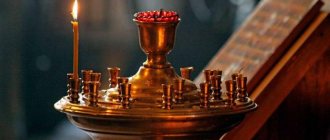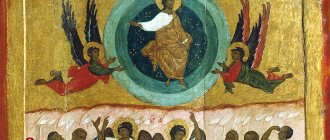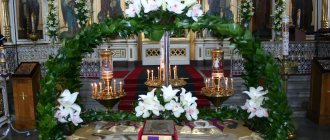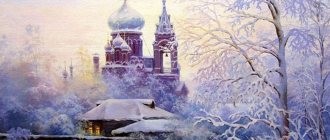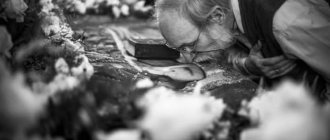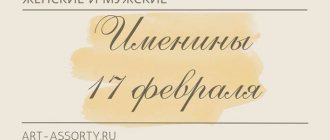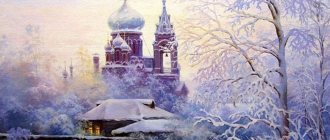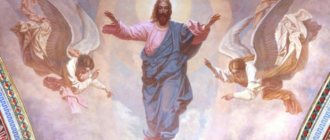Radonitsa is a parent's day of remembrance of deceased ancestors. The essence of the holiday, history, traditions, signs. What can and cannot be done? Images.
Radonitsa - parent's day of remembrance of ancestors
What date will Parents' Day be in 2022?
Parents' Day or Radonitsa is celebrated on Tuesday, the 9th day after Easter. In 2022 it falls on May 3.
When are the memorial days after Easter?
Red Hill or Fomino Resurrection is the first Sunday after Easter. In 2022 it will be May 1st. Red Hill is also called Antipaskha (similar to Easter).
Radonitsa will be celebrated in two days, on May 3, on Tuesday of St. Thomas Week.
The essence of the holiday Radonitsa
Radonitsa is a parent's day of remembrance of deceased ancestors. The holiday has pagan roots (Easter of the Dead). The real name Radonitsa or Radunitsa comes from the word joy . For the first time after Easter, Orthodox Christians visit the graves of their relatives and friends to rejoice at the Resurrection of Christ together with the departed. On this day of remembrance there is no place for sorrow.
What is parent's day and what date is it?
Radonitsa is called parent's day . Like parental Saturdays, this is an all-church day of special remembrance of the dead. But, since it is celebrated on Tuesday, it is called “parents day” and not “parents Saturday”. The name “memorial day” is also not synonymous with Radonitsa, because the essence of the term memorial day is the commemoration of all departed Christians . Although the Russian Orthodox Church calls for this, in folk tradition, parents and relatives are remembered more on Radonitsa.
Memorial days in the traditions of the Slavs
- Rusalia . Rusaliy is an ancient pagan Slavic holiday and the ancestor of folk traditions of commemorating the dead. The Russian Orthodox Church condemns him.
- Easter of the Dead - It was believed that from Easter to Radonitsa the dead visit houses and celebrate their Easter, and deceased priests serve them.
- Grandfathers or fathers are memorial days for Belarusians and Ukrainians. These days, deceased grandfathers, souls, parents return to their homes for a funeral dinner.
- At the zadushnitsa, the Southern Slavs distributed food to neighbors and the poor, decorated graves, lit candles and lit bonfires, which illuminated the path to the earthly world for the dead souls.
- “Zadushki are days of remembrance among the Catholic Slavs, timed to coincide with the days of All Saints (01.11) and the Souls of Dead Relatives (02.11).” This is how stranglings are done in Poland.
Read more: memorial days among the Slavs and peoples of the world
History of the holiday Radonitsa
The Slavic folk holiday Radonitsa goes back to the pagan idea of the spring “resurrection” of nature after the long Russian winter.
This memorial day is symbolized by greenery, grass and fresh flowers.
Both rain and sun - all signs of spring nature are coming to Radonitsa.
Customs and traditions are determined by the ancient “pre-Christian” history of the holiday.
- Thousands of years before the baptism of Russia, the Slavs remembered their dead ancestors , believing in their afterlife and rejoicing in the new cycle of earthly life.
- The Russian Orthodox Church, although it did not include Radonitsa in the church canon as a day of remembrance of the faithful departed , Orthodoxy approved and supported this folk tradition.
Therefore, Radonitsa is a holiday for Orthodox Christians and a memorial day for parents, when cemeteries and churches are visited.
Radonitsa - Easter of the Dead
Easter of the Dead is an echo of pagan tradition and folk beliefs. During Holy, Easter or Radonitsa weeks, the Lord, in the representation of the ancestors, opens heaven and hell and releases the souls of the dead so that they can visit the homes of loved ones and celebrate their Easter of the Dead .
Hailing to the Ancestors
Calling the dead to Radonitsa is a pagan and almost forgotten rite. essence is that it was necessary to cry and lament over the grave, begging the deceased to appear or give some kind of sign or voice. As a rule, women called out to their parents, but the tradition of calling out to the dead was not universal among the ancient Slavs.
How is it customary in Orthodoxy to remember the dead?
The main forms of commemoration of the dead (not the “dead”, but rather “those who fell asleep” before the general resurrection) include:
- prayer performed at home;
- church prayer both during special services dedicated to the deceased, and simply during the liturgy;
- alms that are given to relatives and friends about the soul.
You can pray at home both for a baptized Orthodox Christian and for a person who was not a member of the Church - with the hope of God’s mercy for this soul.
Priests usually advise turning to the Lord both in your own words and, especially, in prayers compiled by the Church. They not only help the soul of a deceased loved one, but also pacify the person praying, especially those grieving in the first days and months after the death of a loved one.
Commemoration during worship is possible only for a baptized deceased. It could be
- funeral service, performed, as a rule, on the third day after death; it is carried out both directly “at the grave” and in absentia, if it is not possible to deliver the body to the temple, or to invite a priest home; During Bright Week, funeral services in absentia are not performed;
- a forty-day commemoration during the liturgy (Sorokoust), when the priest takes out particles of repose from the prosphora;
- prayer for repose at the litany;
- A memorial service is a special funeral service for the dead.
Church prayer for those who are baptized but have taken their own lives without permission is prohibited.
Almsgiving in memory of the deceased is especially useful for the soul.
- things of the deceased - to the poor, as well as those simply wishing to accept them as a memory of the person;
- donations to churches, monasteries, treatment of the sick, and generally helping those in need;
- a form of almsgiving is a funeral feast - a funeral meal.
What can you do on Radonitsa
Order the production of a monument
What should Orthodox Christians do?
- On the eve of Radonitsa, you need to submit a note of repose with the names of loved ones at the church candle shop and order a magpie or liturgy.
- Bring a sacrifice to the temple. On Parents' Day, eve tables for offerings are set up in the center of the temple. Orthodox Christians give bread, cereals, fruits, sweets, and flour. When accepting the offering, the priests commemorate those for whom their relatives bring gifts.
- On Parents' Day, Orthodox Christians visit cemeteries . You need to clean up the grave, take care of the monument and flower garden. On Radonitsa, annual living plants take root well in the flower beds of graves. Orthodox Christians must light a lamp or candle and pray .
- If you can’t visit the temple, you can remember the dead with prayer at home in front of the icon.
Why do people go to the cemetery on Radonitsa?
First of all, on Parents' Day, cemeteries are visited to share with the deceased the joy of the Resurrection of Christ.
And offer a prayer from the resting place.
On Radonitsa, graves are cleaned and fresh flowers and ornamental plants are planted. On this bright holiday, nature itself calls to decorate the burial site.
What do they put on the funeral table for Radonitsa?
- Lent is over , so you can eat meat again. Radonitsa often falls on the May holidays, when barbecues in the country or in nature become the rightful owners of the table.
- The traditional funeral table includes kutya, kolivo, pancakes, pies, fish snacks , as well as kvass, compote and jelly .
- Spring is taking its toll, and what spring table would be complete without fresh herbs and vegetables ?
- The universe, through the mouths of Orthodox priests, warns: do not abuse alcohol!
What not to do on Radonitsa?
- The priests urge on this day not to grieve or be sad for deceased loved ones.
- You cannot refuse help, alms, or alms.
- It is not good to quarrel , use foul language or remember ancestors with anger or resentment.
- Funeral feasts can be joyful, but without excessive consumption of alcohol.
- The Russian Orthodox Church categorically condemns occult practices and mysticism: fortune telling, summoning spirits, calling out to the dead , and gambling .
Read more: What not to do on Parents' Saturdays
Pictures and postcards
Radonitsa is a bright holiday in memory of parents. Orthodox Christians and everyone who wants to remember their ancestors exchange pictures and postcards . The website Solenovaniya.ru designed cards for Radonitsa and Parents' Saturdays so that the picture and text on your friends' smartphones look like your personal message .
Radonitsa - time to decorate the graves of ancestors
Parents day
Time to remember your parents
Share!
Folk signs
- Hailing the rain. On Parents' Day they expected rain. The girls waited because they believed: having washed themselves on Radonitsa with rainwater, they would remain beautiful and young for a long, long time . The peasants remarked: “Rain on Radonitsa means harvest and abundance . The children also called out to the rain: when the adults are happy, something will fall for them too.
- But they also rejoiced at the good weather on Radonitsa. The ancient Slavs believed that the dead sent them sunny days as a sign of their miraculous protection from heaven.
- It is not customary to plant or sow anything in the garden on Radunitsa . Whatever the weather, on this day . ” The origins of this custom are to give free time to peasants to remember their parents. But decorating the grave and planting fresh flowers is not only possible, but also necessary.
- Just like on Easter, eggs are painted on Radonitsa. A festive table with kutya, pancakes, fresh herbs and colored eggs looks festive and joyful.
Etymology
According to J. Lauciute, the word was borrowed from the Balts: lit. raudine “prayer for the dead with weeping and lamentation”, lit. rauda “crying with lamentation”[3]. According to M. Murko and A. V. Desnitskaya, the name Radunitsa
was rethought (through rapprochement with
glad, joy
) derived from the Greek.
ροδωνια “rose bush, rose garden” - tracing paper from Lat. Rosalia
"day of roses" with the same meaning of "feast of the remembrance of the dead" [4] (a similar etymology is generally accepted for the name of the holiday
Rusalia
).
M. Vasmer objected to such an etymology of Russian. Radunitsa
, referring to the absence of a similar term for commemoration in the Central Greek language, and considered the most acceptable understanding
of Radunitsa
as a holiday of joyful Easter commemoration of the dead and its rapprochement with
rad-
(“joy, joy”) [5].
Compare the Polesie name of the holiday - Joyful Grandfathers
.
This fully corresponds to both the dialect names of this holiday (actively bringing Radunitsa
to
rejoicing
), and the Christian perception of Easter[2], meaning the joy of the risen Christ and the coming general resurrection of the dead[6].
Notes
- Dictionary of the Russian language, 1995, p. 126.
- ↑ 123
Agapkina, 2009, p. 390. - Lauchyute Y. Perun, Veles
and Balto-Slavic issues // [www.inslav.ru/images/stories/pdf/1983_Balto-slav_etnojaz_otnoshenija_tezisy.pdf Balto-Slavic ethno-linguistic relations in historical and areal terms]. - M.: Nauka, 1983. - P. 30. - Desnitskaya A.V.
On the issue of Balkanisms in the vocabulary of East Slavic languages // [nkslav.ru/library/files/ssl-viii-1978-jazykoznanije.pdf Slavic linguistics: VIII International Congress of Slavists. M., 1978.] S. 166-167. - Vasmer, 1987, p. 31.
- [skudelnica.ru/radonica/ Spiritual life]
- Vostokov, 1852, p. 120.
- ↑ 123
Dahl/Rainbow, 1880-1882. - Sapiga, 1993.
- Melnikov, 1875.
- Bogdanovich, 1895, p. 56.
- Agapkina, 2009, p. 389.
- ↑ 123
Agapkina, 2009, p. 391. - [www.trm.md/ru/social/crestini-ortodocsi-sarbatoresc-blajinilor/ Orthodox Christians celebrate the Days of Remembrance of the Dead]
- Snegirev, 1838, p. 47.
- Agapkina, 2002, p. 566.
- Dahl/Remember, 1880-1882.
- Mitrofan, 1991, p. 121.
- Typikon, ch. 50, “Sunday of Antipascha”, 3rd “zri”
- [azbyka.ru/otechnik/Afanasij_Saharov/o-pominovenii-usopshikh-po-ustavu-pravoslavnoi-cerkvi/3_13 About the commemoration of the dead according to the charter of the Orthodox Church]
- Bulgakov, 1993, p. 653.
- [newsby.org/by/2012/04/23/text23958.htm Radonitsa: How to behave in a cemetery]
- Dobrovolsky, 1914, p. 764-765.
- Baranova et al., 2001, p. 474.
- Grushko, Medvedev, 1996, p. 484.
- ↑ 12345
Corinthian, 1901, p. 246-247. - [www.unn.ru/folklore/fzaklich.htm Zaklichki]. NNU
- Ney, 2012, p. 62–63.
Funeral traditions
During pagan times, the day of Radonitsa was conventionally divided into 3 important parts.
- The morning was devoted to work;
- At lunchtime they went to the churchyard where they commemorated the dead, left food there, and after meals they could sleep on the mound (grave).
- The evening was dedicated to fun, and a festive table was set.
Throughout the week of Radonitsa, it was customary to leave food on the table; it was believed that at midnight the departed relatives would be able to refresh themselves after a long winter.
The main funeral dish is kutia.
In modern culture, the tradition of visiting a cemetery has been preserved, having undergone some changes.
Previously, it was customary to leave food at the grave: porridge, eggs painted in onion skins, pies. In addition to food, a glass of clean spring water was provided. Some of the food was necessarily buried in the ground, and some was distributed to others or fed to animals.
In the evening there were celebrations. People sought to share the joy of meeting the dead. We tried to get the whole family together for the meal. Three extra plates and cutlery were always placed on the table for the spirits who came to see the light.
Another tradition of the radonite was the preparation of a bath and clean bed linen. Clean linen was left in a heated bathhouse and left for a day. At this time, no one alive entered there. A day later, people were looking for traces of spirits in the bathhouse.
About the fallen spoon
In the Russian North, after preparing a funeral dinner, all windows and doors were opened, and relatives on the threshold met invisible deceased ancestors. After the meal, “Eternal Memory” was sung on the street, and then the owner of the house hung on the window the canvas on which the coffin had previously been lowered into the grave. Thus, he hinted to the guests that it was time to say goodbye.
In other regions, it was believed that deceased relatives on Easter of the dead come into their home and participate in a common meal, so a festive feast was arranged for them, and extra cutlery was placed on the table according to the number of deceased in the family. The same number of empty plates were placed. Each of those sitting at the table had to scoop up a treat from his plate and put it on the plate of the deceased. In the Smolensk region they believed that ancestors ate with the same spoons as those sitting at the table. Therefore, from time to time the spoon was necessarily placed on the table so that the soul of the deceased could take it and eat it.
But if a spoon fell on the floor, it was forbidden to pick it up. It was believed that this soul coming to the holiday gives a signal of its presence. If the funeral dinner was not prepared on time or the relatives violated the rules (for example, squabbles and swearing began at the table or the hostess wiped the funeral bread with a dirty rag), the souls became angry, offended and left home ahead of schedule. This promised troubles and a troubled life for unlucky relatives. Until the next Easter of the Dead, an offended soul could come into the house, knock on windows or doors at night, walk around the hut, break dishes, and appear in difficult dreams.
Other names
rus. Radunitsa, Rodonitsa, Radovnitsa, Radolnitsa, Radonnitsa, Radoshno, Radoshnitsa, Radozhnoe, Radunets, Joyful, Hearty Sunday, Redomnoe Sunday
[2], Navi farewell, Navi day [7];
in Ukraine: Mogilki, Grobki
[8];
in Belarus: Naviy day, Parental, Radovantsi, Deceased Radovanitsa, Radovan commemoration
[8];
Ukrainian Say goodbye, Babsky Great Day, Dead Great Day[9][10], Belorussian. Nebozhchitsky great day[11], Radaunica, Radunitsa, Radanitsa, Radunitska Dziady, Vyalykdzen of the Dead
, forest. Grandfathers are joyful.
Literature
- Agapkina T. A.
[www.inslav.ru/images/stories/pdf/2002_Agapkina_%20Mifopoeticheskie_osnovy_slav'anskogo_narodnogo_kalendar'a_Vesenne-letnij%20_cikl.pdf Mythopoetic foundations of the Slavic folk calendar. Spring-summer cycle]. - M.: Indrik, 2002. - 816 p. — (Traditional spiritual culture of the Slavs. Modern research). - Radunitsa / [www.inslav.ru/index.php?option=com_content&view=article&id=831:2011-08-29-08-34-05&catid=12:2009-08-05-10-49-56&Itemid=22 T. A. Agapkina] // Slavic antiquities: Ethnolinguistic dictionary: in 5 volumes / Under the general editorship. N. I. Tolstoy; Institute of Slavic Studies RAS. - M.: International Relations, 2009. - T. 4: P (Water Crossing) - S (Sieve). - pp. 389-391. — ISBN 5-7133-0703-4, 978-5-7133-1312-8.
- Baranova O. G., Zimina T. A., Madlevskaya E. L. and others.
Russian holiday. Holidays and rituals of the folk agricultural calendar. Illustrated Encyclopedia / Scientific. ed. I. I. Shangina. - St. Petersburg: Art-SPB, 2001. - 668 p. — (History in the mirror of everyday life). — ISBN 5-210-01497-5. - Bogdanovich A. E.
Remnants of the ancient worldview among the Belarusians.
Ethnographic essay. - Grodna: Provincial Printing House, 1895. - 186 p. (Reprinted by: Bagdanovich Adam Yagoravich.
The stories of the ancient world of Belarus. Ethnagraphic stories. - Minsk: Belarus, 1995. - 186 pp. - 6000 copies. - ISBN 985-01-0057-5.) - Bulgakov S.V.
[log-in.ru/books/sv-bulgakov-nastolnaya-kniga-svyashenno-cserkovno-sluzhitelya-bulgakov-sergeiy-vasilevich-spravochniki/ Handbook of priests and church ministers]. - M.: Publishing department of the Moscow Patriarchate, 1993. - 1794 p. — ISBN 5-87301-066-8. - Grushko E., Medvedev Y.
[books.google.com/books?id=Rjt-AAAAMAAJ Dictionary of Russian superstitions, spells, signs and beliefs]. - Russian merchant, 1996. - ISBN 9785882040474. - Remember // Explanatory dictionary of the living Great Russian language: in 4 volumes / author's compilation. V. I. Dal. — 2nd ed. - St. Petersburg. : Printing house of M. O. Wolf, 1880-1882.
- Joy/Rainbow // Explanatory dictionary of the living Great Russian language: in 4 volumes / author's compilation. V. I. Dal. — 2nd ed. - St. Petersburg. : Printing house of M. O. Wolf, 1880-1882.
- Dobrovolsky V. N.
[www.bibliophika.ru/index.php?id=3173 Smolensk regional dictionary]. — Smolensk: Printing house P.A. Silina, 1914. - 1022 p. - Korinfsky A. A.
Radonitsa - Krasnaya Gorka // People's Russia. - M.: Publication of bookseller M.V. Klyukin, 1901. - P. 241-248. — 723 p. - Maksimov S.V.
Radunitsa // Unclean, unknown and godly power. - St. Petersburg: Partnership of R. Golike and A. Vilvorg, 1903. - 529 p. - Melnikov-Pecherskiy P.I.
[az.lib.ru/m/melxnikowpecherskij_p/text_0060.shtml In the forests. Book two]. - M., 1875. - Mitrofan (Alekseev V.N.; monk).
[azbyka.ru/vera_i_neverie/zhizn_posle_smerti/zagrobnaja-zhizn-all.shtml Afterlife: How our dead live and how we will live after death - according to the teachings of the Orthodox Church, according to the premonition of the universal human spirit and the conclusions of science. - Playback ed. St. Petersburg, 1897]. - K.: Raduga, 1991. - 330 p. — ISBN 5-88490-030-9. - Ney V.A.
Easter. Red hill. Traditions, rituals, recipes. - M.: Ripol Classic, 2012. - 251 p. — ISBN 538603989X. - [books.google.ru/books?id=7Ug-AQAAMAAJ&pg=PA120&dq=%D0%9D%D0%B0%D0%B2%D1%8C%D0%B8+%D0%BF%D1%80%D0%BE% D0%B2%D0%BE%D0%B4%D1%8B&hl=ru&sa=X&ved=0CCsQ6AEwA2oVChMIs-K6nrDNyAIVw9YsCh1E1AK6#v=onepage&q=%D0%9D%D0%B0%D0%B2%D1%8C%D0%B8%20 %D0%BF%D1%80%D0%BE%D0%B2%D0%BE%D0%B4%D1%8B&f=false Experience of the Regional Great Russian Dictionary, published by the second department of the Imp. Academy of Sciences] / ed. A. Kh. Vostokova. - SPb.: Imp. Academy of Sciences, 1852. - XII, 275 p.
- Sapiga V.K.
Ukrainian folk saints and names. - K.: T-vo "Knowledge of Ukraine", 1993. - 112 p. — ISBN 5-7770-0582-9. (Ukrainian) - Holy Rus'. Great Encyclopedia of the Russian People. Russian Orthodoxy. In three volumes. / Ch. editor, compiler O. A. Platonov. - M.: Institute of Russian Civilization, 2009. [krelib.com/files/Religion/Pravosl_3_Plat.pdf Volume 3: R - Z]. — 752 p.
- [etymolog.ruslang.ru/index.php?act=xi-xvii Dictionary of the Russian language XI - XVII centuries. Vol. 21]. - M.: Nauka, 1995. - P. 126. - 280 p. - (Russian Academy of Sciences. Institute of Russian Language). — ISBN 5-02-011253-4.
- Snegirev I.
Russian common holidays and superstitious rituals. (Issue 3). - M.: University Printing House, 1838. - 214 p. - Funeral / Tolstaya S. M. // Slavic antiquities: Ethnolinguistic dictionary: in 5 volumes / Under the general editorship. N. I. Tolstoy; Institute of Slavic Studies RAS. - M.: International Relations, 2009. - T. 4: P (Water Crossing) - S (Sieve). — P. 162—169. — ISBN 5-7133-0703-4, 978-5-7133-1312-8.
- [starling.rinet.ru/cgi-bin/response.cgi?root=%2Fusr%2Flocal%2Fshare%2Fstarling%2Fmorpho&basename=morpho\vasmer\vasmer&first=1&text_word=Radunitsa&method_word=beginning&ww_word=on&ic_word=on&sort=word&encoding=utf-rus Radunitsa ] // [etymolog.ruslang.ru/vasmer.php?id=431&vol=3 Etymological Dictionary of the Russian Language] = Russisches etymologisches Wörterbuch: in 4 volumes / author.-comp. M. Vasmer; lane with him. and additional member-corr. USSR Academy of Sciences O. N. Trubacheva. — Ed. 2nd, erased - M.: Progress, 1987. - T. III: Muse - Syat. — P. 431.
Dangerous Observation
It is clear that it was impossible to see the ancestors present at the table. But when curiosity overpowered, some daredevils decided on a desperate experiment. The whole day before the Passover of the Dead they fasted and remained silent in order to become like the dead.
Then, during the funeral dinner, they climbed onto the stove and looked at the feast through the clamp. In Polesie, chips from the coffin were burned on the stove. So supposedly one could see ancestors sitting at the table and even hear them talking with predictions - what troubles would befall their relatives, who in the family would get sick, and who would soon die. There were few who wanted to climb onto the stove, because it was believed that whoever spied on the souls of the dead would soon follow them.
You may also be interested in:
Amulet Flower of Life Garnet Stone- Amulet Symbol of the Family in the Sun
- Celtic Love Knot Amulet
Amulet Alatyr silver- Bracelet Fern Flower - Symbol of the Family
- Leather belt 24 Futhark Runes, Thor's Hammer
